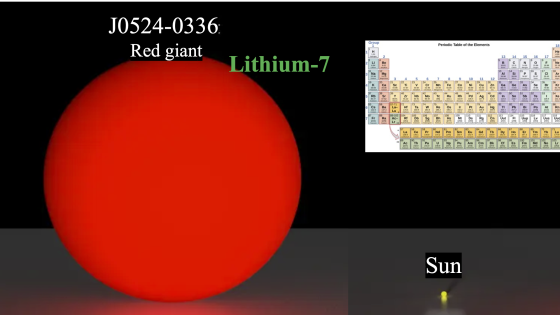Newly discovered star with the highest lithium content in the Universe
Astronomers have long known that in the realm of Sun-like stars, the older star, the less lithium it contains in its photosphere. According to a comparison with the composition of meteorites, the Sun itself has about 200 times less lithium than when it was born 4.57 billion years ago. Although details are lacking, it is firmly established that this decline in the photospheric abundance of lithium over time in low-mass stars is due to nuclear burning of lithium in their envelope where strong turbulence and mixing occur. However, the spectroscopic analysis of a very old star that was among the first ones to form in our Galaxy approximately 12 billion years ago, revealed that it had more than 1000 times more lithium than any young star in the Milky Way, and 100’000 times the solar value. This extraordinary finding agrees with the theoretical prediction of a model proposed two decades ago by an astrophysicist from UNIGE, co-author of the discovery publication in The Astrophysical Journal.
 Comparative sizes of the Sun and the red giant J0524-0336, ultrarich in lithium.
Comparative sizes of the Sun and the red giant J0524-0336, ultrarich in lithium.
Credit: Corinne Charbonnel.
The star, named J0524-0336 based on its coordinates in space, was discovered by Rana Ezzeddine from the University of Florida and collaborators, including Corinne Charbonnel from the Department of astronomy of the University of Geneva, as part of the R-Process Alliance survey which objective is to search for the oldest stars in the Milky Way using several all sky surveys, such as the LargeSky Area Multi-Object Fibre Spectroscopic Telescope (LAMOST), in which J0524-0336 was found. To measure J0524-0336’s elemental composition and determine its fundamental properties, the team used Magellan Inamori Kyocera Echelle (MIKE) spectrograph on the Magellan-Clay Telescope at Las Campanas Observatory. “We found that J0524-0336 contains 100,000 times more lithium than the Sun does at its current age,” said Ezzeddine.
A star undergoing an extremely short lithium-flash?
The team explored several possibilities to explain the extraordinary lithium content of J0524-0336. The hypothesis that lithium was gained from the recent engulfment of an exceptionally lithium-rich planet was excluded, as it is inconsistent with our current understanding of the composition of planets and their host stars. The possibility of a recent binary merger with a white dwarf companion, which could have driven the production of fresh lithium when the two stars shared a common envelope, remains open.
The strongly favoured explanation is, however, that the lithium was produced by J0524-0336 itself at a very specific phase of its evolution. Stellar evolution models computed by Charbonnel with the code STAREVOL showed that J0524-0336 is an evolved red giant star estimated to be approximately 30 times the size of the Sun. More precisely, it could be in an extremely rapid and as-of-yet unobserved phase in the evolution of low-mass stars as they approach the end of their “life”. “In 2001, we had predicted that all low-mass stars should undergo a very strong lithium enrichment at two very specific phases of their evolution, after which the fresh lithium would quickly burn and disappear. Because the Lithium-rich phases should be extremely brief (a few thousand years, compared to the age of 12 billion years of J0524-0336, i.e., 1 million times shorter than the age of J0524-0336), we called this event the “lithium-flash”, and we had very little hope to observe it happening”, says Charbonnel. The well-determined characteristics of J0524-0336 place it exactly in one of these two phases. The study further evidenced other aspects of this process in the spectrum of J0524-0336, including the signs of enhanced mass loss with possible outflows.
Ezzeddine and collaborators hope to use a continuous monitoring program to track the star’s compositional changes over time and to observe different wavelengths, such as infrared light and radio waves, to see if any material is being ejected from the star. If they find a build-up of dust in a disk circumstellar to the star, or the ring of debris and materials being ejected from the star, this would support the stellar interaction hypothesis. In the event that such a disk is not observed, the lithium enrichment would be attributed to a process such as the lithium flash occurring within the star, thereby providing definitive support for this model.
“This is a fantastic discovery, which opens a new window on the interior of stars, as well as on how lithium is produced in galaxies”, concludes Charbonnel.
link to the article on ApJ
September 26, 2024News
